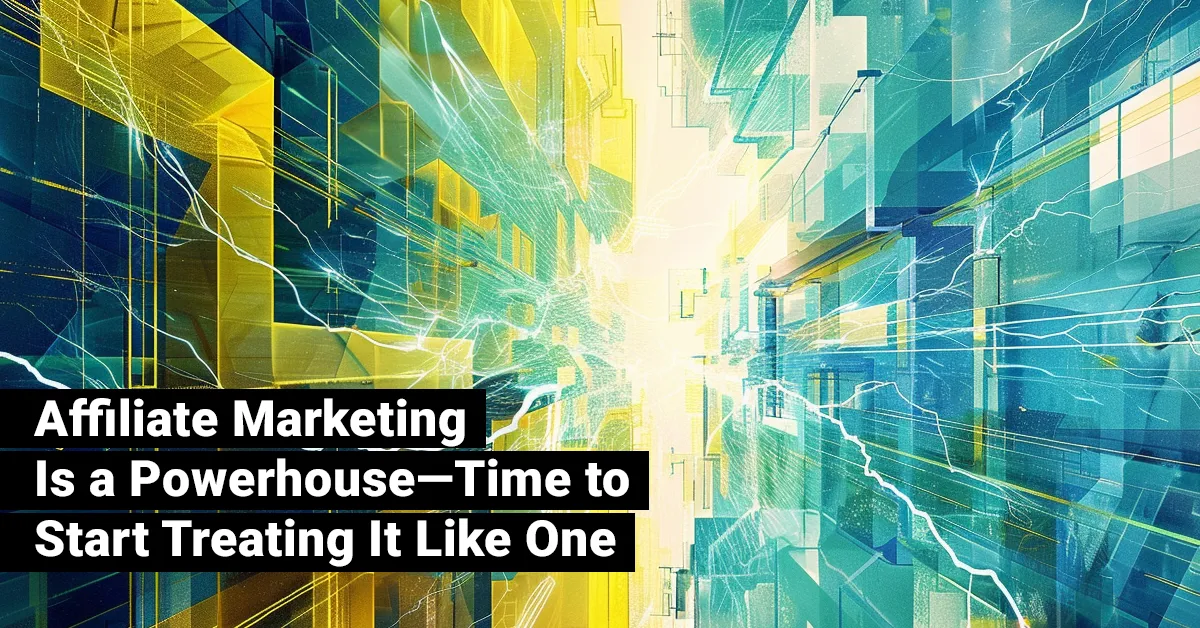Affiliate marketing has come a long way. Once viewed as the scrappy, underappreciated kid brother in the marketing family, it’s now grown into a sophisticated powerhouse—capable of driving results across the entire consumer journey. Yet, despite its evolution, affiliate marketing still doesn’t always get the respect (or budget) it deserves. It’s time to change that narrative.
From the Basement to the Boardroom
In the early days, affiliate marketing was straightforward: offer a commission to partners who could drive a final sale, and watch the ROI roll in. Simple, right? Brands thrived with this “last-click” approach, which worked wonders in delivering results at the bottom of the funnel.
But today, relying solely on a basic CPA model is like bringing a calculator to a coding competition—it’s functional, but woefully outdated. The consumer journey has become a labyrinth of touchpoints, and affiliate marketing has evolved into an ecosystem that spans from discovery to conversion. And guess what? It’s driving serious growth for brands that know how to play the game.
Social Media as Affiliate Marketing’s New Frontier
Social media has turned the affiliate space into the wild west of opportunity. Influencers, content creators, and even meme accounts are partnering with brands to create authentic connections that lead to sales. Instagram posts, TikTok challenges, and YouTube unboxings aren’t just content—they’re conversion engines.
Want to see affiliate marketing in action? Look no further than TikTok, where a 30-second product demonstration can spark a frenzy. Case in point: those viral cleaning products or trending leggings you saw everywhere last year? Many of those campaigns were fueled by affiliate deals, mixing upfront placements with CPA structures that rewarded sales.
Traditional media hasn’t been left behind, either. Outlets like BuzzFeed and The New York Times have embraced affiliate marketing through new commerce focused teams, crafting listicles like “The 15 Best Kitchen Gadgets You Didn’t Know You Needed” that subtly—and successfully—drive purchases. When done right, affiliate marketing doesn’t just ride the wave of trends; it creates them.
Old-School Affiliates: Reinvented and Reigning Supreme
It’s not just the newcomers stealing the spotlight. Cashback, coupon, and deal sites—the OGs of affiliate marketing—have evolved into consumer-centric powerhouses. Take Rakuten Rewards or Savings.com for example. They’ve built massive loyal audiences who turn to them for deals and cashback offers, becoming trusted resources for consumers and brands alike.
These affiliates aren’t just discount hubs—they’re marketing machines. By understanding consumer behavior, they help brands acquire new customers, increase average order values (AOV), and drive repeat business. And let’s be honest: brands that think they can get these top-tier partners on board without budget flexibility are in for a rude awakening. Affiliates like these know their worth, and they aren’t afraid to ask for upfront placements, higher CPAs, or hybrid agreements to sweeten the deal.
Why CPA Alone Doesn’t Cut It Anymore
Running a successful affiliate program in today’s landscape requires more than just a competitive CPA offer. Imagine trying to build a winning sports team but only paying players if and when they score. Without proper investment in training, strategy, and support, even the best talent won’t stick around—or perform at their best for long. Similarly, affiliates with significant influence, whether at the top or bottom of the funnel, expect investment beyond commissions.
Take high-profile publications, for instance. Want your brand featured in a coveted holiday gift guide? You’ll need to pony up for a guaranteed placement. Hoping to partner with a prominent influencer who drives engagement like a freight train? Better have a hybrid deal ready, combining upfront payments and/or seed products with performance incentives.
And if you think this dynamic applies only to upper-funnel partners, think again. Even traditional affiliates, like cashback and deal sites, often require upfront fees to showcase your brand to their massive, ready-to-spend audiences. Why? Because they’ve invested in building platforms, newsletters, and social followings that consumers trust—and brands need.
Affiliate Marketing is A Smart Investment, Not a Shortcut
At JEBCommerce, we’ve seen it all. Brands that come in thinking affiliate marketing is a magic bullet, only to be surprised when results require a mix of strategy, budget, and long-term commitment. Yes, affiliate marketing is performance-driven, but it’s not a “set-it-and-forget-it” channel. Treat it as such, and you’ll be left scratching your head, wondering why the big players aren’t picking up your affiliate link.
Here’s the deal: Affiliate marketing works because it’s adaptable. It combines the immediacy of digital ads, the authenticity of influencer marketing, and the measurability of performance-based payouts. But success requires treating it as a legitimate investment, not a marketing afterthought.
Here’s how this might look in practice:
- Top-Funnel Partners: Content sites, influencers, and media publications often create demand and build trust. To leverage their value, brands may offer upfront payments, flat fees for sponsored placements, free product, custom CPC (Cost per Click) offers, or even a combination of fixed and performance-based incentives.
- Mid-Funnel Partners: Affiliates like review sites or comparison platforms bridge the gap between awareness and purchase. They’re instrumental in influencing consumer decisions, so hybrid models—similar to top-funnel partners or even increased CPA rates for new vs returning customer acquisitions—can motivate their efforts.
- Bottom-Funnel Partners: Cashback, coupon, and deal sites continue to excel at converting interested, or even hesitant, shoppers into buyers. While they often operate on a traditional CPA basis, offering placement fees for premium exposure or higher commissions during key seasons can yield significant ROI.
Real Examples of Affiliate Marketing Done Right
Let’s take a look at some real-world examples. A major travel brand partnered with influencers and content sites to drive awareness during quarterly seasonal campaigns. They invested in guaranteed placements in top-tier publications, hybrid deals with creators for video content and blog placements, and custom hybrid offers for deal and cashback affiliates to capture last-minute shoppers. The result? A triple-digit increase in traffic and a dramatic rise in new customer acquisition, all while improving channel ROI by over 60%.
Another example: a home decor brand wanted to considerably boost its holiday sales. By working with deal, coupon, and cashback partners to feature limited-time offers and exclusive deals, they increased both AOV and repeat purchases alongside revenue. Upfront fees and custom placements played a role, but the ROI justified every penny spent with results surpassing 1,100% YoY growth.
The Path Forward: Affiliate Marketing with Intention
The days of running an affiliate program on autopilot are over. To succeed, brands must embrace the following principles:
- Budget for Success: Affiliate marketing isn’t free. Allocate funds for upfront placements, hybrid deals, and guaranteed media inclusions to ensure you’re partnering with the best.
- Focus on Relationships: Partnerships are the foundation of affiliate marketing. Make sure to prioritize building strong connections with affiliates to maximize value for your brand and the consumer you are trying to convert.
- Adapt to the Funnel: From awareness to conversion, affiliate marketing can cover it all—but only if you diversify your approach and partners. Our channel can change quickly, as does consumer behavior, so don’t sleep on testing new ideas and new partners along the way.
- Test, Analyze, Repeat: Continue testing new payout models, new partners, and unique strategies. Analyze the results on a monthly and quarterly basis to determine which economics are delivering the best results based on the partner category and where the consumer is being met within their purchase journey. Repeat this process throughout the year and you’ll quickly realize that your affiliate channel has evolved considerably over time.
Affiliate marketing has proven it deserves a seat at the table. With the right strategy, budget, and partnerships, it’s not just a channel—it’s a catalyst for growth. And at JEBCommerce, we’re here to help brands unlock their full potential. So, are you ready to give affiliate marketing its fair due? Let’s talk.






